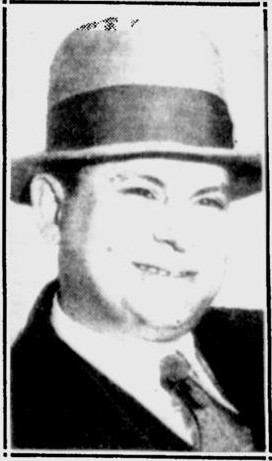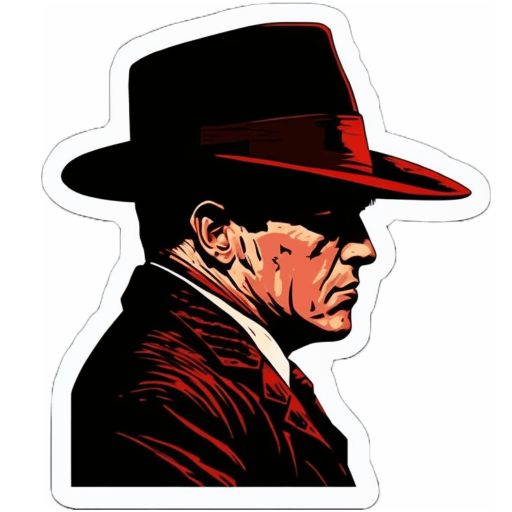Death of Leonardo Loffredo, 1910
On August 3, 1910, saloon keeper Leonardo Loffredo of Orsara di Puglia (southern Italy), 45, was at his tavern at 300 Bishop early in the day — the same tavern later connected to August Chiaverotti and the Italian anarchists.
Later, Loffredo was shot three times with a .32 and killed almost instantly. When he reached Dr. Aaron Yaffe at 12:45pm he had three bullet wounds, including one on the top of his head and died of a brain hemorrhage. Loffredo’s nephew Matteo Delsonno, 23, wrestled the gun from the slayer’s hand and beat him unconscious. Laborer Antonino Basile, 34, was taken in for questioning, arrested but found not guilty.
Apparently, the altercation began after Basile hit Leonardo’s 11-year old son Joseph with a fishing pole, and Loffredo confronted him about the incident. Witness August Incelli, a steamfitter, told the coroner that Basile had beat both his son and Loffredo’s son with the pole, which had irritated Loffredo. Joseph ran inside the saloon, crying, and Leonardo stepped out, asking, “If you have any trouble with my boy, why don’t you take it up with me?” After being warned not to come closer, the intoxicated Loffredo ignored Basile, and called him a “son of a whore”. Basile’s wife told Loffredo to “let it go”, telling him “there will be trouble”. Loffredo again ignored the warning, stepped forward and took the shots. Anna Barbieri Loffredo was left to raise three sons alone.
Death of Joseph “Dago Pete” Paolo, 1931
The evening of February 26, 1931 found John “Cross-Eyed Jack” Loffredo, a former automobile salesman and another son of Leonardo, sharing a drink and conversation with Mike Delsonno at the latter’s pool hall in St. Francis, just south of the city limits. While pouring yet another glass of wine and soda, in walked Joseph “Dago Pete” Paolo, also known as the “bad man of Bay View”, who operated the Idlewild roadhouse near Cudahy. Loffredo said hello to Pete, and he shared a few drinks with the various men present, but soon the small talk erupted into an argument over “tribute” money that Paolo felt Loffredo owed. Paolo said that if he was not paid $300, he would turn Loffredo in to the feds for operating a still. Loffredo told Paolo he had no money with him and that Pete would have to go “knock off” the still to get his cut.
Loffredo left the establishment with Julio DeSideri of Cicero, Illinois, and they drove off in the snow. DeSideri had been a boarder with Loffredo for roughly two months, and had no record other than being questioned following the murder of state’s attorney William McSwiggin in Chicago. Getting only a block away, a freight train on the Northwestern tracks blocked the road, so they made a U-turn back past the building. Paolo was outside, and he yelled, “You cocksucker! I’ll blow your head off.” Dago Pete fired his .45 at the car, shattering the windshield, and a gun fight broke out; moments later, Loffredo drove away and Paolo wound up dead with three shots to the chest. Witnesses to the mess were Sam DeAllesandro and Ambrose Marinelli, 32. Matteo Delsonno, Loffredo’s step-father, falsely told police that he did not know who shot Paolo.
Loffredo fled, causing sheriffs from six counties to actively look for him. While searching, police uncovered seven stills and made six arrests during three raids.

Jack Loffredo
Prohibition Raids
They first caught Joseph Fare at 2448 South Delaware Avenue, who had two 200-gallon copper stills, forty-five 50-gallon barrels of mash, 2200 pounds of corn sugar and thirty gallons of whiskey. Arrested with him were August Zanchetti, 56, and Quinto Pierotti, 28.
Police next went to the home of Ciro Tamboli, 44, of 3129 South Hanson Avenue, and discovered a still column fourteen inches by twenty-four feet, which extended from the basement, through a bedroom and up into the attic. They destroyed five 2500-gallon vats of mash. Also there was a 30-gallon barrel of alcohol and fourteen 1-gallon cans of alcohol. Arrested with Tamboli was his cousin Ruggiero Tamboli of Memphis. (Tamboli later tried to have the evidence suppressed on the grounds that it was an illegal search, but his motion was denied.)
The third home was at 1839 East Euclid Avenue, Loffredo’s residence. John Buonanaoma was inside with four 200-gallon stills, as well as one hundred gallons of whiskey and raw alcohol.
On Monday, March 2, 1931, the various bootleggers appeared before Commissioner Floyd Jenkins and posted bond. The bond ranged from $500 for Quinto Pierotti up to $1000 each for Joseph Fare and Ciro Tamboli. Hearings were adjourned until Saturday, where Pierotti was freed and everyone else was bound over for trial.
Loffredo turned himself in to Detective Louis Dieden at his home 36 hours after the shooting, after first consulting with Michele Vitucci. Loffredo was questioned for an hour by Captain Harry Ridenour and claimed that Paolo fired the first shot and his actions were in self-defense. Loffredo only shot because he was scared and fled for the same reason, leaving behind his wife Mary Carlone Loffredo and 19-month-old son Leonard. He was held in jail without charge pending the coroner’s inquest.
After the inquest on the evening of March 4, 1931, Loffredo appeared in court the next morning with his attorney, Thomas Edward Leahy. He was formally charged by District Attorney George Bowman with carrying a concealed weapon and with second-degree murder, which had a maximum of twenty-five years in prison. His bail was set at $10,000. “There is no doubt that the witnesses lied about some things,” said Bowman. “Their stories do not jibe and we have evidence that leads us to believe a second degree murder charge can be successfully pressed, despite the apparent self-defense that Loffredo claims.”
Bowman also sent police out to pick up Matteo Delsonno for more questioning, believing he had perjured himself during the inquest. Delsonno had previously served five years in Waupun for assault and robbery and was not someone seen as trustworthy. A search of the South Side resulted in nothing at his brother’s pool hall or residence.
Trial
At the trial, the government’s star witness was George Steffen, a railroad employee. Putting a fatal hole in Loffredo’s story, Steffen said that no freight train was passing by at the time Loffredo claimed one was. Matteo Delsonno also admitted that he had lied to the police when he told them he did not know who killed Paolo. Finally, Detective Dieden testified that he found no glass at the crime scene from Loffredo’s automobile. The implications were clear: even if Loffredo had acted in self defense, he was less than honest about what had transpired overall.
Coming to the aid of the defense, surprisingly, was county pathologist Dr. Edward Louis Tharinger. Tharinger found a bullet embedded in a porch across the street from Delsonno’s pool hall, and a ballistics test showed that the projectile’s markings matched those created by the gun found near Paolo’s body.
The bullet was actually found after the trial began, making the discovery quite a surprise for the prosecution, who had suggested the victim’s gun was planted.
Deputy District Attorney Adelbert John Beyer’s closing argument was simple. “Pete Paolo was put on the spot,” he said. “With gangland’s customary shrewdness, self defense arguments have been built around the case. Does the law of self defense apply to gang members? Are we going to allow gangsters to shoot it out among themselves and then free them on self defense pleas?”
As of Thursday, April 16, 1931, the jury had deliberated for thirty-one hours and were believed to be deadlocked. Judge Shaughnessy dismissed them for the night and said if a verdict was not reached in the morning, a hung jury would be declared.
While the jurors were out, Loffredo was free on bond and spent little time in the courtroom. He spent Thursday evening in Delsonno’s pool hall. Conversely, Julio DeSideri seemed so interested in what the decision would be that he stayed in the Safety Building and had his dinner, spaghetti, brought in for him.
Verdict
At 8:40am on Friday morning, a total of forty-one hours and twenty minutes since they started, the jury returned with its verdict: guilty of murder in the second degree. Interviewed in his cell, Loffredo expressed disappointment. “They might as well have called it first degree murder,” he said. “I am no racketeer. I’ve lived here nearly all my life and I’m a good citizen. Them farmers may think it’s murder, but that doesn’t alter the facts.”
Sentencing
On Saturday, May 2, 1931, Jack Loffredo was sentenced to sixteen years in Waupun by Judge Shaughnessy. When asked if he had anything to say, Loffredo stuck his thumbs in his vest pockets and defiantly called out to the judge, asking if he should have been “a human target” for Paolo. The judge responded that he should be grateful the jury let him off so easy after testimony from Mrs. Josie Paolo that the gun found by the dead man was not his. “What does she know about his gun?” Loffredo snapped. “He didn’t live with her.”
[Even if Loffredo had beaten the charges, he would have been referred to the federal authorities after four stills were found in his home. Perhaps most interesting, Mrs. Paolo sat side by side in the courtroom with Florence Erna Wangerin (who used the alias Flo Walker), Pete’s mistress, as they comforted each other.]
Defense attorney Thomas Leahy said he would consider an appeal. Loffredo was given until Monday to go to Waupun in order to first say goodbye to his wife and two children — his second son, Nicholas, was only three weeks old.
Peter Loffredo
Trouble was not quite over for the Loffredo family. On May 21, 1931, Jack’s brother Peter was involved in an accident in West Allis. When police arrived, they discovered twelve gallons of moonshine in his vehicle. Loffredo’s 13-year old passenger, Edith Ermi, suffered mild injuries.
On June 3, 1931, a charge against Matteo Delsonno of pointing and aiming a revolver was dismissed by Judge George Page when he proved an alibi. During Loffredo’s trial, Deputy Sheriff John Paul Schrank had claimed that Delsonno pointed the gun at him during a fight on April 7, 1930. Delsonno claimed he had spent that day at an election booth getting the returns, and he had seven witnesses to vouch for him.
Jack Loffredo Pardoned, 1934
After serving only three years, Loffredo was pardoned on July 14, 1934 by Governor Albert George Schmedeman. The District Attorney’s office had a change of heart and sent a letter to Madison saying Loffredo only fired because Paolo shot first.
Loffredo lived a full life, passing in December 1982.
